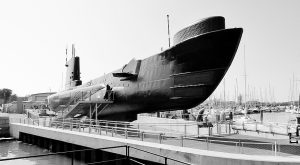During the month of April 1967, the submarine HMS ‘Alliance’ was operating in home waters in the South of England and for a day or two anchored off Lundy. One submariner, whose name is unknown, came ashore and probably spent some time in the Tavern. On his return to the ship something happened to him and search parties both from the ship and from the island turned out to search for him. He was found hiding in the bushes somewhere on the side of the cliffs. The seaman was returned to his ship where he no doubt received the ‘due attention of his officers.’
Robert “Dave” Davey, the engineer on the island at the time had apparently been instrumental in the rescue of this seaman. Dave Davey had arrived on the island in 1964; he retired in 1981 and died sometime in the early 1990s. Soon after this incident, he received a handwritten letter from the commander of the submarine thanking him for turning out for the search and apologising for the problems that the man had given to everyone. A transcript of that letter is given here.
“H. M. S. Alliance at Sea,
22nd April 1967.
Dear Mr. Davey,
May I thank you and your friends (I regret I don’t know all their names), for so willingly turning out to search for this very stupid man. He was hiding in the bushes slightly up the cliff. At present he has no idea what all the fuss is about and we are in the process of informing him. It was such a dangerous manoeuvre that not only did it risk his life but the lives of us and particularly of yourselves. Again may I thank you and I hope you haven’t too bad an impression of us.
Yours sincerely,
T. E. Woods (Illegible), Lieutenant Commander Royal Navy.”
I made enquiries regarding H.M.S. Alliance and was very pleased to learn that she has been preserved and now forms part of the Royal Navy Submarine Museum in Gosport. She is the only surviving example of the A Class ‘Amphion’ class submarines. She was built by Vickers in Barrow-in-Furness and commissioned in 1947, serving in the Far East and in home waters. She had a crew complement of 5 officers and 56 ratings, was 87 feet in length with a beam of 22 feet and had a surface displacement of 1,620 tons. Her armament  consisted of ten torpedo tubes and two external 4 inch guns. She was decommissioned in 1973 and served as a training ship in Southampton until 1979, when she was preserved as a memorial to those British submariners who had died in service and is now part of the Submarine Museum at Gosport. She has been completely restored through an £11.00 million Heritage Lottery grant and is now available for visitors.
consisted of ten torpedo tubes and two external 4 inch guns. She was decommissioned in 1973 and served as a training ship in Southampton until 1979, when she was preserved as a memorial to those British submariners who had died in service and is now part of the Submarine Museum at Gosport. She has been completely restored through an £11.00 million Heritage Lottery grant and is now available for visitors.
I contacted the Submarine Museum in Gosport, asking for any information they may have on the event and for the name of the commander of the submarine, as his signature on the letter is illegible.
I received a reply from the Portsmouth archives officer at the Museum. He confirms that the submarine was operating in home waters at the time and could well have anchored off Lundy, as she had made a Port visit to Falmouth around that period. He also confirmed the name of the captain, Lt. Commander T.E. Woods RN, in command of the ship from1966 to 1967. He has compared Commander Wood’s signature on the letter with his signature in the ship’s log book and confirmed that they agree. Apparently the records of the ship shed no further light on the incident.
There are many unanswered questions in this matter. Why did Lt. Commander Woods say that the seaman was ‘hiding up the cliff’? He does not say that he had fallen over the cliff side. He also states that the man ‘has no idea what all the fuss is about’, as if the seaman was either too drunk or otherwise incapacitated to remember the incident. In his letter Commander Woods states ominously that they are “in the process of informing him”. One feels that there should be an exclamation mark inserted after this comment.
This whole incident brings back memories of similar situations when drunken lighthouse keepers staggering back to the South Light from the tavern, fell over the cliffs and had to be rescued.
Roger Allen.
______________________________________________





